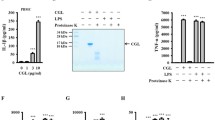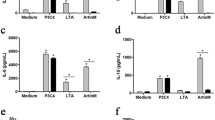Abstract
Synthesis of nitric oxide (NO) is one of the important effector functions of innate immune cells. Although several reports have indicated mistletoe lectins induce immune cells to produce cytokines, studies regarding the activities of the lectins in the production of NO have been very limited. Here, we report on the induction of NO synthesis in a murine macrophage cell line, RAW264.7, by Korean mistletoe lectin (KML-IIU). When the macrophage cells were treated with KML-IIU in the presence of a suboptimal concentration of IFN-γ, NO production was induced in a concentration-dependent manner. Significantly higher levels of NO were induced by subchains of the KML-IIU (A and B), which have lower toxicities, as compared to the hololectin. Furthermore, expression of the inducible nitric oxide synthase (iNOS) gene was elevated in accordance with the level of NO production. When the synthase was inhibited by iNOS inhibitors (L-NIL and L-NAME), NO production was specifically reduced in a concentration-dependent manner. Our studies demonstrate that the KML-IIU and its subchains induce NO production in murine macrophage cells via activation of the iNOS gene expression, suggesting that the KML-IIU subchains may be used as an immunomodulator to enhance the effector functions of innate immune cells.
Similar content being viewed by others
References
Bantel H., Engels I.H., Voelter W., Schulze-Osthoff K. and Wesselborg S. Mistletoe lectin activates caspase-8/FLICE independently of death receptor signaling and enhances anticancer drug-induced apoptosis. Cancer Res. 59: 2083–2090, 1999
Beuth J., Stoffel B., Ko H.L., Jeljaszewicz J. and Pulverer G. Immunomodulating ability of galactoside-specific lectin standardized and depleted mistletoe extract. Arzneimittelforschung 45: 1240–1242, 1995
Hajto T., Hostanska K., Fischer J. and Saller R. Immunomodulatory effects of Viscum album agglutinin-I on natural immunity. Anticancer Drugs 8(Suppl 1): S43–S46, 1997
Franz H. Mistletoe lectins and their A and B chains. Oncologia 43(Suppl 1): 23–34, 1986
Ribereau-Gayon G., Jung M.L., Baudino S., Salle G. and Beck J.P. Effects of mistletoe (Viscum album L.) extracts on cultured tumor cells. Experientia 42: 594–599, 1986
Ribereau-Gayon G., Dumont S., Muller C., Jung M.L., Poindron P. and Anton R. Mistletoe lectins I, II and III induce the production of cytokines by cultured human monocytes. Cancer Lett. 109: 33–38, 1996
Hajto T., Hostanska K. and Gabius H.J. Modulatory potency of the beta-galactoside-specific lectin from mistletoe extract (Iscador) on the host defense system in vivo in rabbits and patients. Cancer Res. 49: 4803–4808, 1989
Lavelle E.C., Grant G., Pusztai A., Pfüller U. and O’Hagan D.T. Mucosal immunogenicity of plant lectins in mice. Immunology 99: 30–37, 2000
Lavelle E.C., Grant G., Pusztai A., Pfüller U. and O’Hagan D.T. The identification of plant lectins with mucosal adjuvant activity. Immunology 102: 77–86, 2001
Soler M.H., Stoeva S. and Voelter W. Complete amino acid sequence of the B chain of mistletoe lectin I. Biochem. Biophys. Res. Commun. 246: 596–601, 1998
Vervecken W., Kleff S., Pfuller U. and Bussing A. Induction of apoptosis by mistletoe lectin I and its subunits. No evidence for cytotoxic effects caused by isolated A- and B-chains. Int. J. Biochem. Cell Biol. 32: 317–326, 2000
Yoon T.J., Yoo Y.C., Choi O.B., Do M.S., Kang T.B., Lee S.W., Azuma I. and Kim J.B. Inhibitory effect of Korean mistletoe (Viscum album coloratum) extract on tumor angiogenesis and metastasis of haematogenous and non-haematogenous tumor cells in mice. Cancer Lett. 97: 83–91, 1995
Yoon T.J., Yoo Y.C., Kang T.B., Her E., Kim S.H., Kim K., Azuma I. and Kim J.B. Cellular and humoral adjuvant activity of lectins isolated from Korean mistletoe (Viscum album coloratum). Int. Immunopharmacol. 1: 881–889, 2001
Männel D.N., Becker H., Gundt A., Kist A. and Franz H. Induction of tumor necrosis factor expression by a lectin from Viscum album. Cancer Immunol. Immunothera. 33: 177–182, 1991
Xie Q. and Nathan C. The high-output nitric oxide pathway: role and regulation. J. Leukoc. Biol. 56: 576–582, 1994
Deng W., Thiel B., Tannenbaum C.S., Hamilton T.A. and Stuehr D.J. Synergistic cooperation between T cell lymphokines for induction of the nitric oxide synthase gene in murine peritoneal macrophages. J. Immunol. 151: 322–329, 1993
Moncada S., Palmer R.M. and Higgs E.A. Nitric oxide: physiology, pathophysiology, and pharmacology. Pharmacol. Rev. 43: 109–142, 1991
Nathan C. Nitric oxide as a secretory product of mammalian cells. FASEB J. 6: 3051–3064, 1992
Lowenstein C.J. and Snyder S.H. Nitric oxide, a novel biologic messenger. Cell 70: 705–707, 1992
Stuehr D.J. and Nathan C.F. Nitric oxide. A macrophage product responsible for cytostasis and respiratory inhibition in tumor target cells. J. Exp. Med. 169: 1543–1555, 1989
Nathan C.F. and Hibbs J.B. Jr. Role of nitric oxide synthesis in macrophage antimicrobial activity. Curr. Opin. Immunol. 3: 65–70, 1991
Jenkins D.C., Charles I.G., Thomsen L.L., Moss D.W., Holmes L.S., Baylis S.A., Rhodes P., Westmore K., Emson P.C. and Moncada S. Roles of nitric oxide in tumor growth. Proc. Natl. Acad. Sci. USA 92: 4392–4396, 1995
MacMicking J., Sie Q. and Nathan C. Nitric oxide and macrophage function. Annu. Rev. Immunol. 15: 323–350, 1997
Chan J., Ganaka K., Carroll D., Flynn J. and Bloom B.R. Effects of nitric oxide synthase inhibitors on murine infection with Mycobacterium tuberculosis. Infect. Immun. 63: 736–740, 1995
Nilcholson S., Bonecini-Almeida Mda G., Lapa e Silva J.R., Nathan C., Xie Q.W., Mumford R., Weidner J.R., Calaycay J., Geng J., Boechat N., Linhares C., Rom W. and Ho J.L. Inducible nitric oxide synthase in pulmonary alveolar macrophages from patients with tuberculosis. J. Exp. Med. 183: 2293–2302, 1996
Yoon T.J., Yoo Y.C., Kang T.B., Shimazaki K., Song S.K., Lee K.H., Kim S.H., Park C.H., Azuma I. and Kim J.B. Lectins isolated from Korean mistletoe (Viscum album coloratum) induce apoptosis in tumor cells. Cancer Lett. 136: 33–40, 1999
Kang T.B., Kim J.B., Yoo Y.C., Yoon T.J., Song S.K. and Do M.S. Studies on the immunological function of Korean mistletoe lectin; Tumor necrosis factor-α inducing activity of Koean mistletoe lectin and its subchains. Korean J. Lab. Anim. Sci. 17: 187–194, 2001
Smith P.K., Krohn R.I., Hermanson G.T., Mallia A.K., Gartner F.H., Provenzano M.D., Fujimoto E.K., Goeke N.M., Olson B.J. and Klenk D.C. Measurement of protein using bicinconinic acid. Anal. Biochem. 150: 76–85, 1985
Laemmli U. Cleavage of structural proteins during assembly of the head of bacteriophage T4. Nature 277: 680–685, 1970
Goodwin C.J., Holt S.J., Downes S. and Marshall N.J. Microculture tetrazolium assays: a comparison between two new tetrazolium salts, XTT and MTS. J. Immunol. Meth. 179: 95–103, 1995
Xie Q.W., Cho H., Calaycay J., Mumford R.A., Swiderer K.M., et al. Cloning and characterization of inducible nitric oxide synthase from mouse macrophage. Science 256: 225–228, 1992
Trayhurn P., Duncan J.S. and Rayner D.V. Acute cold-induced suppression of ob (obese) gene expression in white adipose tissue of mice: mediation by the sympathetic system. Biochem. J. 311: 729–733, 1995
Moore W.M., Webber R.K., Fok K.F., Jerome G.M., Connor J.R., et al. 2-Iminopiperidine and other 2-iminoazaheterocycles as potent inhibitors of human nitric oxide synthase isoforms. J. Med. Chem. 39: 669–672, 1996
Connor J.R., Manning P.T., Settle S.L., Moore W.M., Jerome G.M., et al. Suppression of adjuvant-induced arthritis by selective inhibition of inducible nitric oxide synthase. Eur. J. Pharmacol. 273: 15–24, 1995
Mittal C.K. Nitric oxide synthase: involvement of oxygen radicals in conversion of l-arginine to nitric oxide. Biochem. Biophys. Res. Commun. 193: 126–132, 1993
Hajto T., Hostanska K., Frei K., Rordorf C. and Gabius H.J. Increased secretion of tumor necrosis factors alpha, interleukin 1, and interleukin 6 by human mononuclear cells exposed to beta-galactoside-specific lectin from clinically applied mistletoe extract. Cancer Res. 50: 3322–3326, 1990
Männel D.N., Becker H., Gundt A., Kist A. and Franz H. Induction of tumor necrosis factor expression by a lectin from Viscum album. Cancer Immunol. Immunother. 33: 177–182, 1991
Metzner G., Franz H., Kindt A., Fahlbusch B. and Suss J. The in vitro activity of lectin I from mistletoe (ML I) and its isolated A and B chains on functions of macrophages and polymorphonuclear cells. Immunobiology 169: 461–471, 1985
Nicholson S., Bonecini-Almeida M.G., Silva J.R.L., Nathan C., Xie Q.-W., et al. Inducible nitric oxide synthase in pulmonary alveolar macrophages from patients with tuberculosis. J. Exp. Med. 183: 2293–2302, 1996
MacMicking J.D., North R.J., LaCourse R., Mudgett J.S., Shah S., et al., Identification of NOS2 as a protective locus against tuberculosis. Submitted, 1996
Anstey N., Weinberg J., Hassanali M., Mwaikambo E., Manyenga D., et al. Nitric oxide in Tanzanian children with malaria. J. Exp. Med. 184: 557–568, 1996
Stamler J.S. S-nitrosothiols and the bioregulatory actions of nitrogen oxides through reactions with thiol groups. Curr. Top. Microbiol. Immunol. 196: 19–36, 1996
Klebanoff S.J. Oxygen metabolites from phagocytes. In: Gallin J.I., Goldstein I.M., Snyderman R. (eds.), Inflammation: Basic Principles and Clinical Correlates. Raven, New York, 1992, pp. 541–588
Yim C.-Y., Bastian N.R., Smith J.C., Hibbs J.B. Jr. and Samlowski W.E. Macrophage nitric oxide synthesis delays progression of ultraviolet light-induced murine skin cancers. Cancer Res. 53: 5507–5511, 1993
Xie K., Huang S., Dong Z., Juang S.-H., Gutman M., et al. Transfection with the inducible nitric oxide synthase gene suppresses tumorigenicity and abrogates metastasis by K-1735 murine melanoma cells. J. Exp. Med. 181: 1333–1343, 1995
Mannick J.B., Asano K., Izumi K., Kieff E. and Stamler J.S. Nitric oxide produced by human B lymphocytes inhibits apoptosis and Epstein-Barr virus reactivation. Cell 79: 1137–1146, 1994
Timoshenko A.V., Lan Y., Gabius H.J. and Lala P.K. Immunotherapy of C3H/HeJ mammary adenocarcinoma with interleukin-2, mistletoe lectin or their combination: effects on tumour growth, capillary leakage and nitric oxide (NO) production. Eur. J. Cancer 37: 1910–1920, 2001
Langer M., Rothe M., Eck J., Mockel B. and Zinke H. A nonradioactive assay for ribosome-inactivating proteins. Anal. Biochem. 243: 150–153, 1996
Langer M., Mockel B., Eck J., Zinke H. and Lentzen H. Site-specific mutagenesis of mistletoe lectin: the role of RIP activity in apoptosis. Biochem. Biophys. Res. Commun. 264: 944–948, 1999
Author information
Authors and Affiliations
Corresponding author
Rights and permissions
About this article
Cite this article
Kang, T., Yoo, Y., Lee, K. et al. Korean mistletoe lectin (KML-IIU) and its subchains induce nitric oxide (NO) production in murine macrophage cells. J Biomed Sci 15, 197–204 (2008). https://doi.org/10.1007/s11373-007-9210-2
Received:
Accepted:
Published:
Issue Date:
DOI: https://doi.org/10.1007/s11373-007-9210-2




